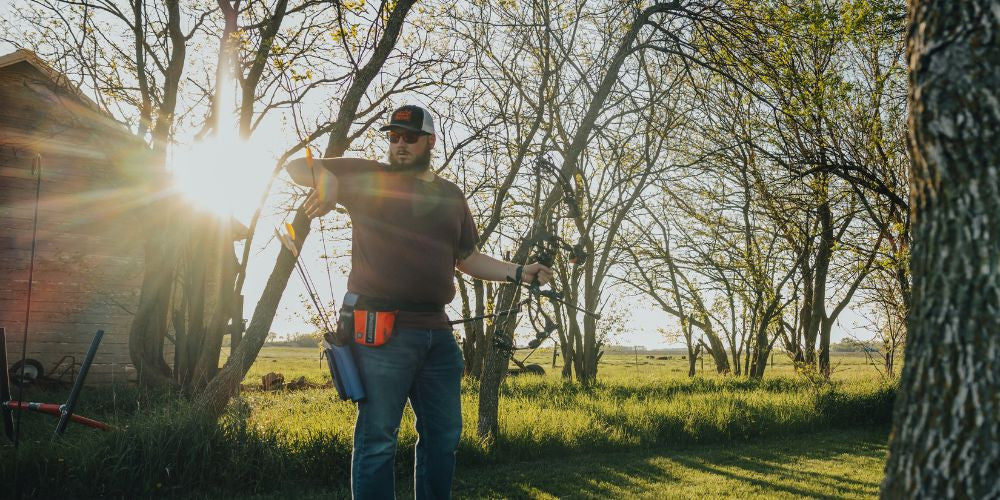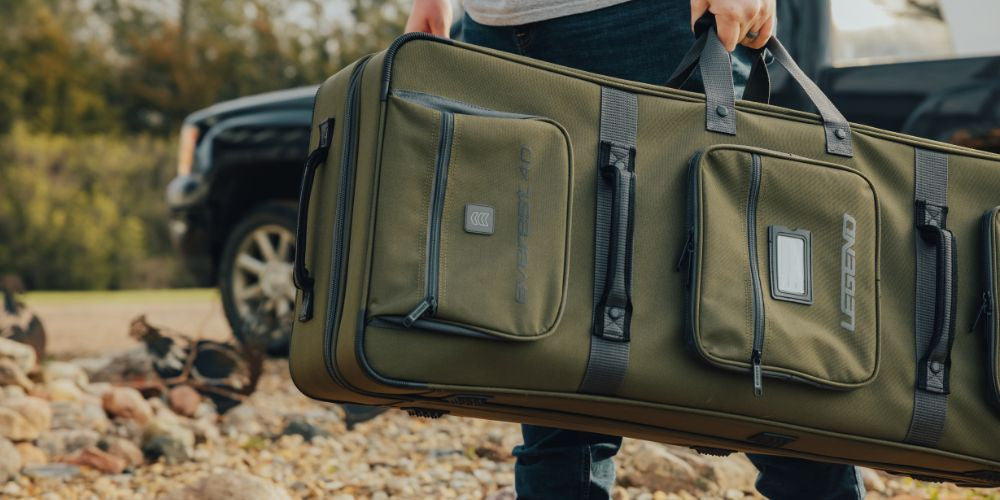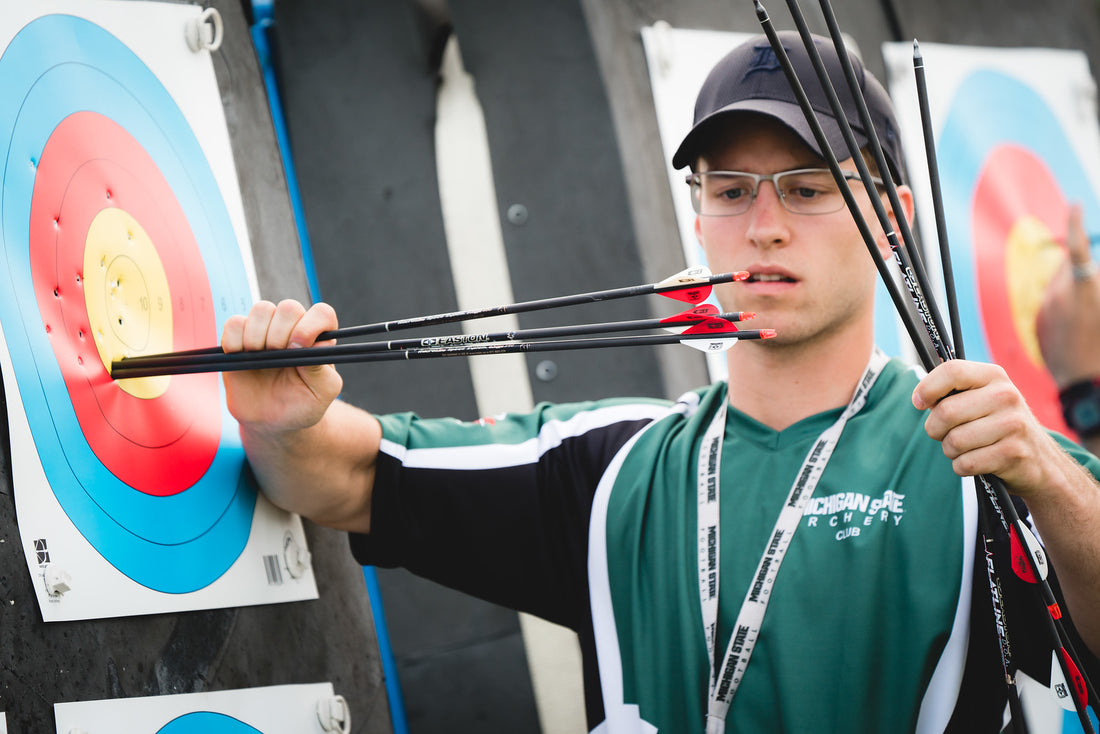When it comes to archery, choosing the right bow is only half the battle. The other half is selecting the correct arrows for your bow. Matching your arrows to your bow is a crucial step that can significantly affect your shooting performance, accuracy, and consistency.
By matching your arrows to your bow, you ensure that the arrow's spine (flexibility) and weight are suitable for your bow's draw weight and draw length. If your arrows are not adequately matched, they may not fly straight, wobble in the air, or even break, causing a potential safety hazard. Moreover, it can cause inconsistency in your shots, and it can be challenging to improve your accuracy and precision.
The Anatomy Of An Arrow

An archery arrow is a specialized type of arrow designed for use in the sport of archery. It has several unique features that make it different from other types of arrows. The anatomy of an archery arrow typically includes the following components:
Shaft
The shaft of an archery arrow is the long, cylindrical part that forms the main body of the arrow. It is usually made of lightweight and durable materials such as carbon fiber, aluminum, or wood. The length and diameter of the arrow shaft can vary depending on the type of arrow and the archer's preferences. Some archery arrows have a tapered shape, with a thinner diameter towards the front end, to reduce wind resistance and improve accuracy.
Nock
The nock is a small plastic or metal piece that is attached to the back end of the arrow shaft. It is designed to snap onto the bowstring and hold the arrow securely in place before release. The shape and size of the nock can vary depending on the type of bowstring used and the archer's preferences.
Arrowhead
The arrowhead is the front end of the arrow that is designed to penetrate the target. The type of arrowhead used can vary depending on the intended use of the arrow. For example, broadheads are used for hunting and have razor-sharp blades that can cause significant tissue damage. Field points, on the other hand, are used for target shooting and have a blunt, rounded tip that is less likely to cause damage to the target. The arrowhead can be made of different materials, such as steel, aluminum, or carbon fiber, and its weight and shape can be adjusted to optimize penetration and accuracy.
Fletching
The fletching of an archery arrow consists of three or more feathers or plastic vanes that are attached to the back end of the shaft. Fletching helps to stabilize the arrow in flight by creating drag and preventing it from spinning. The fletching is typically attached to the shaft with a special glue or tape, and the angles at which the feathers or vanes are set can be adjusted to optimize arrow flight.
Arrow Wrap (Optional)

An arrow wrap is a thin, adhesive-backed vinyl or paper layer that is wrapped around the shaft of the arrow. It can be used to add color and design to the arrow, as well as to protect the shaft from damage. Arrow wraps can also make it easier to see the arrow in flight and to identify arrows that belong to a particular archer or team.
The Different Arrow Materials
Arrow materials play a critical role in the overall performance of the arrow. Different arrow materials offer unique advantages and disadvantages, and choosing the right material for your needs is important for accuracy, durability, and consistency. Here are some of the most common arrow materials used in archery:
Carbon Arrows

Carbon arrows are popular among archers for their strength, speed, and accuracy. They are made of carbon fibers that are tightly woven together, making them lightweight and durable. Carbon arrows have a small diameter, allowing them to fly faster and with less wind drift compared to other arrow materials. They are also more consistent in their performance than other materials, as their stiffness can be precisely controlled during manufacturing.
However, carbon arrows can be more expensive than other materials, and they are prone to breakage upon impact with hard surfaces such as rocks or trees. Additionally, they can be difficult to repair if they become damaged, and they require careful handling to prevent splintering or cracking.
Aluminum Arrows

Aluminum arrows are heavier and larger in diameter compared to carbon arrows. They are made of aluminum alloys and are known for their affordability, durability, and versatility. Aluminum arrows are less prone to bending or warping upon impact than carbon arrows, making them a good choice for hunting or field archery.
However, aluminum arrows can be less consistent in their performance due to manufacturing variations. They can also be more affected by wind drift compared to carbon arrows due to their larger diameter. They can also be prone to developing dents or bends over time, which can affect their accuracy and performance.
Wood Arrows

Wood arrows are the oldest type of arrow and have been used for centuries. They are typically made of high-quality woods such as cedar, spruce, or pine. Wooden arrows offer a classic look and feel, and they are known for their straightness and consistency.
However, wood arrows require more maintenance compared to other materials. They need to be checked regularly for warping, cracks, or splintering, which can affect their accuracy and safety. Wooden arrows are also less durable compared to carbon or aluminum arrows and can break upon impact with hard surfaces.
Fiberglass Arrows
Fiberglass arrows are made of a composite material consisting of woven fiberglass fibers and resin. They are known for their affordability and durability, making them a popular choice for beginners or casual archers. Fiberglass arrows come in various diameters, weights, and lengths, making them versatile and easy to customize.
However, fiberglass arrows can be heavier compared to other materials, affecting their speed and accuracy. They are also less consistent in their performance compared to carbon or aluminum arrows due to variations in manufacturing. Fiberglass arrows can also be prone to bending or cracking upon impact with hard surfaces.
Composite Arrows
Composite arrows are made by combining different materials, such as carbon fiber and aluminum, to create arrows with unique properties. These type of arrows can offer the benefits of both materials, such as lightweight and stiffness from carbon fiber and durability from aluminum. However, they can be more expensive than other types of arrows.
Specs To Consider When Matching Your Arrows to Your Bow
Selecting the right arrows is an important aspect of archery, as it can greatly impact an archer's accuracy and success. Arrow length, point weight, spine weight, inner diameter, and nock size are all key factors to consider when choosing arrows to use with an archery bow. Each of these specifications plays a role in the arrow's flight and compatibility with the bow and other equipment used. Below, we'll take a more detailed look at each of these factors and how they relate to choosing the right arrows for your archery setup.
Arrow Length:
The length of your arrow is also crucial to your shooting performance. An arrow that's too long or too short can affect its accuracy and consistency. Arrow length is measured from the bottom of the nock groove to the end of the arrow, excluding the point. The appropriate length of an arrow is determined by the draw length of the shooter and the type of bow they are using. A good rule of thumb is to add 1-2 inches to the shooter's draw length to determine the appropriate arrow length. For example, if a shooter has a draw length of 28 inches, an arrow length of 29-30 inches would be appropriate. However, it's important to consult the manufacturer's recommendations for the specific type of arrow being used.
Point Weight:

Arrow points, or arrowheads, are attached to the front end of the arrow shaft and are used for different types of archery, such as hunting, target shooting, or field archery. Arrow points come in a variety of weights, typically ranging from 75 to 300 grains. The appropriate point weight is determined by the intended use of the arrow and the bow's peak draw weight. A general rule of thumb is to choose a point weight that is between 5 and 10 grains per pound of draw weight. For example, if a bow has a draw weight of 50 pounds, a point weight of 250-500 grains would be appropriate. However, it's important to consult the manufacturer's recommendations for the specific type of arrow being used.
Spine Weight:
The spine weight of an arrow refers to its stiffness or resistance to bending. When you shoot an arrow, the bowstring pushes it forward, causing it to bend in the middle due to the bow's force. The arrow's stiffness determines how much it bends or flexes. Arrows with too high of a spine weight may be too stiff for the bow, while arrows with too low of a spine weight may be too flexible and cause inconsistent shots.
It's important to choose an arrow with a proper spine weight that matches the draw weight and length of the bow and the shooter's draw length. As your draw weight increases, so should your arrow spine. To determine the correct arrow spine for your bow, you need to consider your bow's draw weight and length. Most arrow manufacturers provide charts to help you determine the appropriate arrow spine rating for your bow. The spine chart factors in your bow weight, arrow length, and arrow point weight. The proper spine measurement ensures that the arrow flexes just the right amount as it leaves the bow, resulting in a straighter and more perfect arrow flight.
Arrow spine weight is typically measured in two ways: static spine weight and dynamic spine weight.
Static Spine Weight:
Static spine weight, also known as the arrow's deflection, refers to the arrow's stiffness or resistance to bending. It's measured by suspending a 28-inch arrow shaft with two points exactly 26 inches apart and adding a 2-pound weight in the middle. The arrow spine weight is then measured in thousandths of an inch of deflection per inch of arrow length. For example, an arrow with a spine weight of 400 would bend 0.400 inches when a 1-pound weight is placed on its center. Arrows with higher static spine weights are stiffer and bend less, while arrows with lower static spine weights are more flexible and bend more.
Dynamic Spine Weight:
Dynamic spine weight, also known as the arrow's actual bend when shot from the bow, is affected by several factors, including the arrow's length, point weight, and fletching weight. The dynamic spine weight is a more accurate way of measuring an arrow's stiffness because it takes into account the weight of the arrow and the bow's energy.
When an arrow is shot from the bow, it experiences different forces, such as the force of the bowstring pushing the arrow forward and the force of the air resistance and gravity pulling the arrow down. These forces can cause the arrow to flex or bend differently than its static spine weight would suggest. Dynamic spine weight is measured by shooting an arrow through a paper target and observing the resulting hole. If the hole is elongated vertically, the arrow is too weak, and if it's elongated horizontally, the arrow is too stiff.
Inner Diameter:
The inner diameter of an arrow refers to the diameter of the arrow shaft. The appropriate inner diameter is determined by the type of arrow point and nock being used, as well as the intended use of the arrow. Arrows with larger inner diameters tend to be heavier and have thicker walls, while arrows with smaller inner diameters tend to be lighter and have thinner walls. It's important to choose an appropriate inner diameter that matches the arrow points and nocks being used.
Nock Size:

The nock size refers to the size and shape of the slot on the end of the arrow that holds the bowstring. The size and shape of the nock slot on the end of the arrow are another important consideration when selecting arrows. The nock size affects the compatibility of the arrow with the bowstring and the type of nock used. Different types of nocks are available, including standard nocks, pin nocks, and bushings. It's important to choose an appropriate nock size and type for the intended use of the arrow and to match it to the bowstring and the type of release aid used. The nocks should fit snugly onto the bowstring without being too tight or too loose, as either can negatively affect arrow flight and accuracy.
Understanding How To Use Arrow Charts

An arrow chart, also known as a "spine chart," is a helpful tool for selecting the right archery arrow for your bow. and shooting style. To use an arrow selection chart, you will typically need to know the draw weight and draw length of your bow, as well as your preferred arrow length and point weight.
Step 1: Determine Your Bow's Draw Weight and Arrow Length
The first step in using an arrow chart is to determine your bow's draw weight and arrow length. The draw weight is the amount of force required to pull the bowstring back to a full draw, and it is usually measured in pounds. The arrow length is the distance from the nock groove to the end of the arrow shaft.
To find your bow's draw weight, check your bow's manual or look for the information printed on the bow limb. If you don't have this information, you can measure it yourself using a bow scale.
To find your arrow length, measure your draw length (the distance from the bowstring at full draw to the grip of the bow) and add 1-2 inches for the arrow length.
Step 2: Consult the Arrow Chart
Once you have your bow's draw weight and arrow length, consult the arrow chart provided by the arrow manufacturer. Each chart is different and takes into account the specific characteristics of the arrows the manufacturer produces.
The arrow chart will typically have a grid format with rows and columns. The rows represent the draw weight of your bow, and the columns represent the arrow length.
Step 3: Find Your Bow's Draw Weight and Arrow Length on the Chart
Find the row that corresponds to your bow's draw weight and the column that corresponds to your arrow length. For example, if your bow has a draw weight of 50 pounds and your arrow length is 28 inches, you would look for the row that shows 50 pounds and the column that shows 28 inches.
Step 4: Look for the Spine Measurement
Once you have located the appropriate row and column on the arrow chart, look for the spine measurement listed in the corresponding cell. This measurement refers to the stiffness of the arrow that is recommended for your setup.
The spine measurement is typically expressed as a number, such as 300, 400, or 500. Arrows with a higher spine measurement are stiffer and will fly straighter, while arrows with a lower spine measurement are more flexible and will bend more during flight.
Step 5: Choose an Arrow with the Recommended Spine Measurement
Choose an arrow with a spine measurement that matches the recommended measurement on the arrow chart. This will ensure that the arrow is the right stiffness for your bow and will fly straight and true.
It's important to note that there are many other factors that can affect the performance of your arrows, such as arrow weight, point weight, and fletching. It's always best to test different arrows and setups to find what works best for you and your bow. But using an arrow chart as a starting point is a good way to ensure that you are using arrows that are appropriate for your bow's draw weight and arrow length.
The Benefits of Matching Your Arrows to Your Bow

Matching your arrows to your bow has several benefits that can improve your archery performance. Below are some of the reasons why you should always match your arrows to your bow:
Accuracy
One of the most significant benefits of matching your arrows to your bow is improved accuracy. When your arrows are properly matched to your bow, they will fly straighter and more consistently. A correctly matched arrow will have the appropriate stiffness to flex just enough as it leaves the bow, resulting in a straighter flight path. As a result, you'll be able to hit your target more accurately and consistently.
Consistency
Matching your arrows to your bow also helps to improve consistency. When you shoot with properly matched arrows, you'll notice that your shots will be more consistent. Your arrows will travel in a straight line, and you'll be able to group your shots more tightly. This consistency is important for archers who compete in tournaments, as it can help them achieve better scores.
Optimal Performance
Matching your arrows to your bow is crucial for optimal performance. If you shoot with arrows that are too light, too heavy, or have the wrong stiffness, you won't achieve the best performance from your bow. When you shoot with properly matched arrows, you'll notice that your bow performs better. The arrows will be easier to shoot, and you'll be able to shoot at a higher velocity.
Prevent Damage to the Bow
When you use arrows that are not matched to your bow, you risk damaging your bow. Arrows that are too heavy or have the wrong stiffness can cause excessive vibration, which can damage your bow. Over time, this can lead to cracks or other damage to your bow. By matching your arrows to your bow, you'll prevent this kind of damage and extend the life of your equipment.
Prevent Injury
Using arrows that are not matched to your bow can also be dangerous. Arrows that are too light or too heavy can cause injury if they don't fly straight. Arrows that don't match your bow's draw weight or length can also cause injury, as they can put too much stress on your bow. By matching your arrows to your bow, you'll ensure that you're shooting safely.
Personalized Shooting Experience
Matching your arrows to your bow allows you to personalize your shooting experience. You can choose arrows with appropriate stiffness, weight, and length to suit your shooting style. Whether you prefer a traditional wooden arrow or a modern carbon arrow, you can find the right arrow for your bow. This personalization can make your archery experience more enjoyable and rewarding.
Conclusion
Matching your arrows to your bow is a critical aspect of archery that should not be overlooked. It ensures your safety, accuracy, consistency, and overall shooting performance. By following the guidelines outlined above, you can select the right arrows for your bow and improve your archery skills.
 cust@legendarchery.com
cust@legendarchery.com 302 503 5767
302 503 5767 Whitestown, In 47075
Whitestown, In 47075




